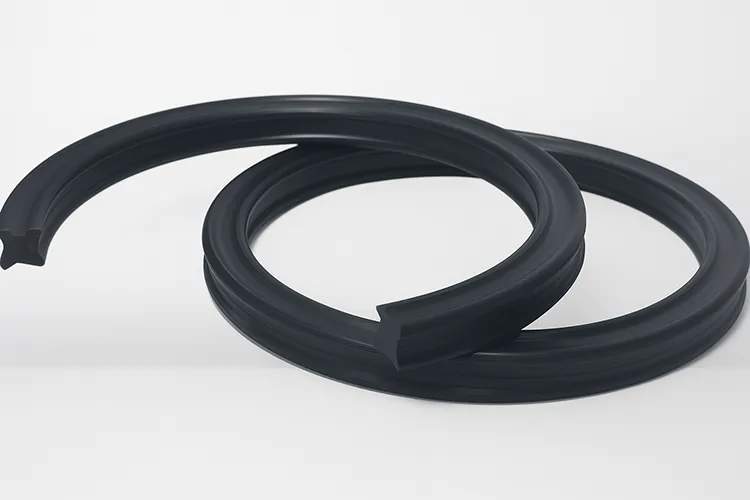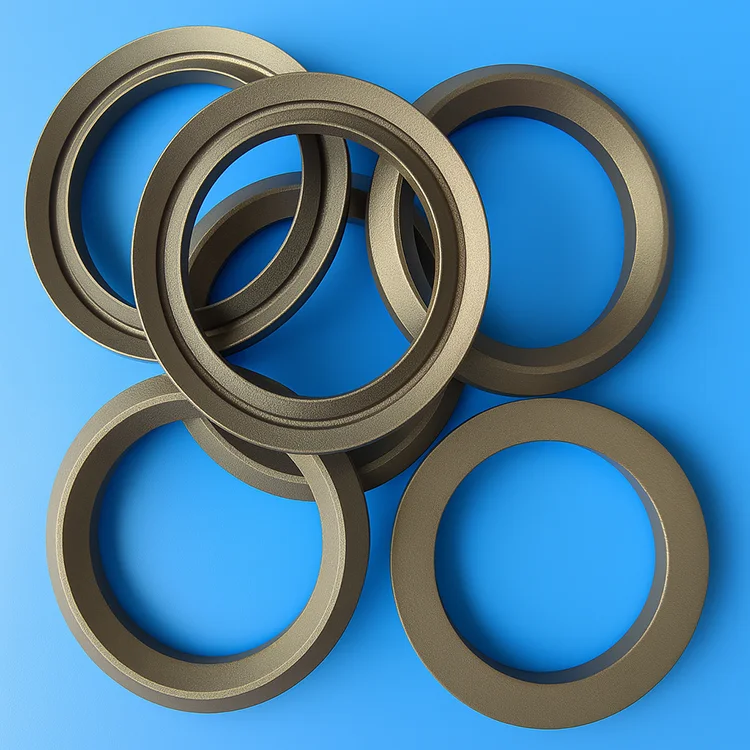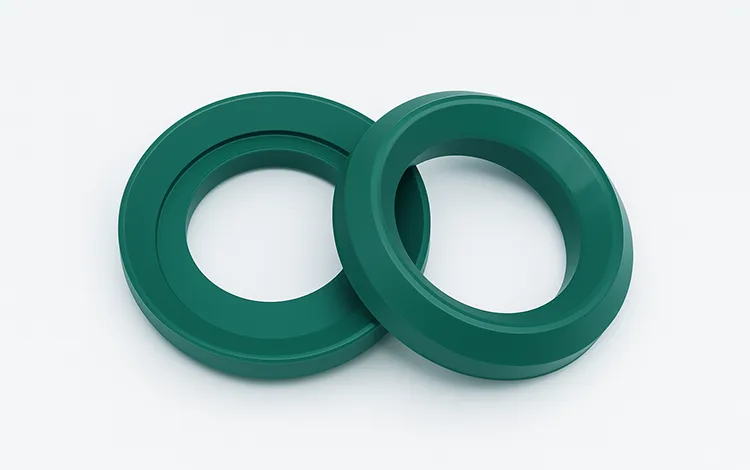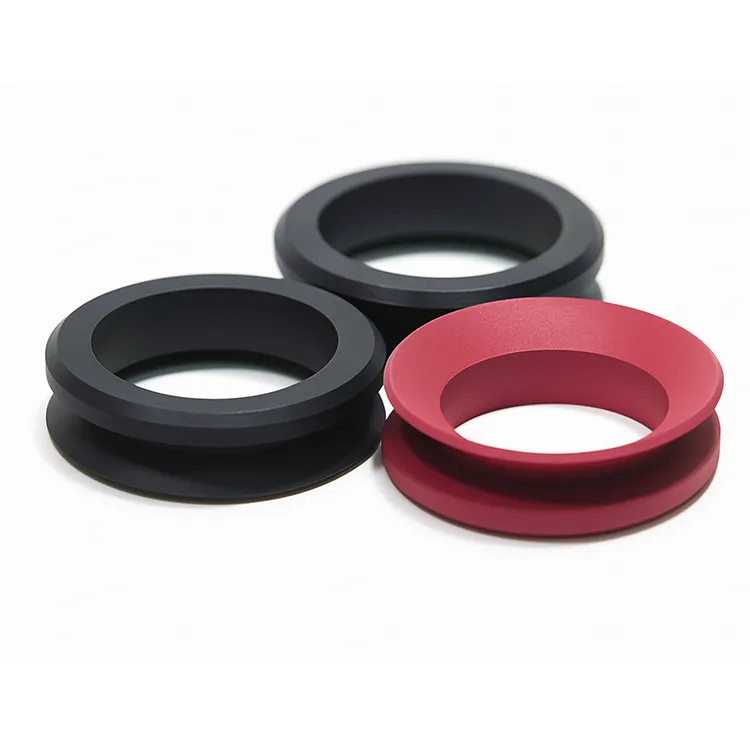I. Introduction
Sealing rings may seem like minor components, but in reality, they’re critical to the efficiency and reliability of machines across every industry. From the rotating shafts in electric motors to the hydraulic pistons in construction equipment, seals are the silent guardians that prevent leakage, contamination, and mechanical failure. Despite their importance, many professionals—especially those outside of the sealing industry—struggle to differentiate between types of seals and their appropriate use cases.
I’ve seen firsthand how misunderstanding sealing ring types can lead to system breakdowns, excessive wear, or even dangerous leaks. And in my daily conversations with product designers, buyers, and engineers, two terms constantly come up: V-rings and X-rings. These rings serve very different purposes, yet they are often mistaken for one another, or chosen incorrectly based on assumptions rather than engineering principles.
So in this article, I want to do two things: first, clearly explain what V-rings and X-rings are, including their structure, function, and applications; and second, debunk several common myths that float around in forums, product catalogs, and even procurement discussions.
Here’s a detailed, no-fluff comparison—based on real engineering, not marketing gloss. Let’s dive in.
II. What Is a V-Ring?
2.1 Structure and Geometry
A V-ring is a unique type of axial shaft seal made entirely from elastomeric rubber. Its design is defined by a distinctive “V”-shaped cross-section that allows it to flex and conform during rotation. Unlike radial seals that require a housing or groove, the V-ring is mounted directly onto the shaft, where it stretches slightly to fit snugly. This self-tensioning fit ensures both alignment and retention without requiring additional hardware.
Because it doesn’t require a gland or groove, the V-ring is especially suitable for applications where space constraints exist. Its light weight and simple profile also contribute to ease of installation—even in retrofit scenarios.
2.2 Sealing Mechanism
The V-ring’s performance hinges on its axial sealing action. Once installed, the V-ring rotates with the shaft while its flexible sealing lip lightly contacts a stationary surface—typically a bearing face, washer, or flange. This creates a barrier that:
- Blocks contaminants such as dust, dirt, water spray, and chemical splash.
- Prevents external ingress, not internal leakage.
- Compensates for shaft misalignments and slight surface imperfections due to its flexibility.
It’s important to note that V-rings are not designed to seal fluids under pressure. Their primary mission is exclusion, making them ideal for protection but unsuitable for high-pressure systems.
2.3 Common Applications
You’ll find V-rings widely used in rotating equipment, particularly where dry conditions and environmental sealing are essential. Typical applications include:
- Electric motor shafts – to shield bearings from dust or splash.
- Bearings and housings – as a protective seal against environmental wear.
- Industrial gearboxes and pumps – where internal pressure sealing isn’t required, but exclusion of external contaminants is.
Because of their simplicity and durability, V-rings are often a go-to solution for long-service industrial environments, especially in food processing, packaging, agriculture, and general manufacturing.
![]()
III. What Is an X-Ring?
3.1 Structure and Geometry
An X-ring, also known as a quad-ring, is a high-performance sealing element designed with a four-lobed cross-section that resembles an “X” or a cloverleaf when viewed in profile. Unlike traditional O-rings, which are circular in cross-section, X-rings offer two sealing contact lines per surface, increasing both sealing efficiency and stability.
The beauty of the X-ring lies in its versatility. It fits into the same grooves used for O-rings, allowing easy upgrades without redesigning the entire assembly. The lobed shape also eliminates the tendency of O-rings to twist during installation or operation—a common cause of seal failure known as “spiral failure” or “rolling.”
3.2 Sealing Mechanism
What sets X-rings apart is their dual-sealing action, which performs under both static and dynamic conditions:
- In static applications, such as face-to-face flanges, the lobed structure provides more sealing surface area, resulting in tighter, more reliable seals with less compression force.
- In dynamic applications (like reciprocating or rotary motion), the X-ring offers lower friction and greater resistance to wear, thanks to better lubrication retention between lobes.
Additionally, the shape ensures even stress distribution, reducing compression set and improving long-term performance—especially under fluctuating pressure or temperature conditions.
3.3 Common Applications
X-rings are ideal when a standard O-ring simply isn’t enough. They are often used in:
- Hydraulic cylinders and valves – where fluid pressure is present and movement is frequent.
- Pneumatic systems – for enhanced sealing in compressed air systems with low to medium pressure.
- Medium-pressure rotary shafts – such as in pumps or actuators, where dynamic sealing is critical and the risk of twisting or extrusion must be minimized.
For engineers seeking a balance between sealing reliability and friction performance, the X-ring is often the preferred choice over traditional O-rings.

IV. Key Differences Between V-Rings and X-Rings
To make the decision-making process easier, here’s a clear side-by-side comparison of the key characteristics that differentiate V-rings from X-rings. This table serves as a quick reference, whether you’re a buyer looking to spec seals for your product or a designer evaluating system requirements.
| Feature | V-Ring | X-Ring |
|---|---|---|
| Shape | V-shaped axial seal | Quad-lobed radial seal |
| Installation | Shaft-mounted, no groove needed | Requires gland or groove |
| Pressure Handling | Low (external exclusion only) | Moderate (for fluid pressure sealing) |
| Sealing Direction | Axial (seals against a face) | Axial and Radial (multi-surface sealing) |
| Primary Function | Contaminant exclusion | Fluid containment |
| Dynamic Friction | Very low | Low (better than standard O-rings) |
Key Takeaways:
- V-rings are best for external protection, especially where there’s no fluid pressure and minimal design space for a groove.
- X-rings offer superior sealing in pressure applications, especially when fluid integrity or motion is involved.
Misapplication is costly—using a V-ring where pressure sealing is needed can result in immediate leakage. Conversely, over-specifying an X-ring for a low-pressure dust seal might unnecessarily increase costs and complexity.

V. Application Comparison
Understanding when to use a V-ring versus an X-ring can save time, money, and mechanical headaches. Below is a breakdown of practical scenarios where each type of seal excels.
5.1 When to Choose a V-Ring
You should opt for a V-ring in the following situations:
- Environmental Exclusion: When your system’s main concern is keeping contaminants like dust, dirt, or moisture out of a bearing or housing. V-rings are excellent in dusty or splash-prone environments.
- No Groove Available: If the design lacks the space or structure to machine a groove—for example, on a rotating shaft—V-rings can be mounted directly without special hardware.
- Low-Pressure, High-Rotation: Ideal for systems like motors or conveyors, where the shaft rotates at high speed but doesn’t involve fluid pressure.
- Cost-Sensitive Projects: With their simple design and easy installation, V-rings are often more economical for basic protection.
Real Example: I once helped a customer replace failed lip seals in a textile machine gearbox with V-rings. The result? Longer service life and zero dust ingress—all without redesigning the housing.
5.2 When to Choose an X-Ring
Choose an X-ring if your system demands reliable, durable fluid sealing, especially under motion:
- Fluid Pressure Sealing: Whether it’s hydraulic oil, water, or air, X-rings can handle moderate pressure ranges (higher than V-rings, though not as high as metal-backed seals).
- Replacing O-Rings: In systems where standard O-rings twist or wear prematurely, X-rings offer superior sealing with less friction and wear.
- Rotary or Reciprocating Motion: X-rings are a better fit for dynamic applications, where rolling or spiraling failure could occur.
- When Downtime Is Expensive: In industries like food processing, chemical transfer, or robotics, where frequent seal failure means production halts, X-rings provide the reliability you can count on.
Pro Tip: If you already have an O-ring groove and need better performance without redesigning, switching to an X-ring is a drop-in upgrade.

VI. Common Misconceptions in the Market
Despite their widespread use, both V-rings and X-rings are frequently misunderstood. These misconceptions can lead to improper selection, performance failures, and unnecessary costs. Let me walk you through the most common ones I’ve encountered in real-world projects and customer discussions.
6.1 Confusion Between Pressure Ratings
Myth: “V-rings can handle fluid pressure just like O-rings or X-rings.”
Reality: V-rings are not pressure seals. Their design is for exclusion only—they block dust, splash, and environmental debris. Some catalogs or forums mistakenly claim they can be used in hydraulic systems, which can lead to catastrophic leaks.
Clarification: The V-ring lip is too flexible and shallow to hold back pressurized fluids. Always check the pressure requirements before specifying any axial seal.
6.2 Wear Resistance Myths
Myth: “V-rings last longer than X-rings because they have less friction.”
Reality: While it’s true that V-rings produce very low friction, this doesn’t equate to greater wear resistance—especially under dynamic loads or harsh media. X-rings, with their dual-sealing lines and improved stress distribution, often outlast V-rings in fluid or motion-intensive environments.
Key Insight: Durability depends on application context, not just material or shape.
6.3 Nomenclature Confusion
Myth: “V-rings” are the same as “V-profile chains” or “V-groove seals.”
Reality: Online catalogs, especially those using machine translation or lacking technical editors, often mislabel sealing rings. I’ve seen buyers mistakenly order V-rings when they actually need a V-shaped O-ring or a V-profile chain guide.
Tip: Always check dimensional drawings or cross-section diagrams, not just names.
6.4 Misleading Efficiency Claims
Myth: “X-rings reduce friction by 50% compared to O-rings.”
Reality: While X-rings do reduce dynamic friction, the actual efficiency gain depends on material, lubrication, motion type, and surface finish. Claims of specific friction reduction percentages are often overstated or purely theoretical.
Best Practice: Use lab-tested data or consult with the seal supplier based on your system’s actual load and motion profile.
6.5 Maintenance Misunderstandings
Myth: “X-rings require no maintenance—they’re a set-and-forget solution.”
Reality: Like all rubber seals, X-rings are subject to wear, chemical degradation, and compression set. Assuming they’re maintenance-free can lead to unexpected leakage or seal hardening over time.
What I Recommend: For high-value systems, schedule regular inspections and cleaning, especially if media is abrasive or if operating temperatures fluctuate.
VII. Expert Tips for Seal Selection
Choosing between a V-ring and an X-ring isn’t just about picking a shape—it’s about understanding the real demands of your application. Over the years, I’ve helped clients in industries ranging from chemical processing to precision robotics, and here’s the framework I always come back to when advising on seal selection:
1. Sealing Direction: Axial vs Radial
- V-rings provide axial sealing—the lip presses against a stationary face.
- X-rings offer radial and axial sealing, thanks to their multi-lobed design.
Ask yourself: Is the seal acting against a face (axial) or inside a groove (radial)?
2. Pressure and Media Compatibility
- If your application involves fluid pressure, especially above 5 bar, lean toward X-rings.
- If it’s dry, low-pressure, or you just need to keep out dust or splashes, V-rings are sufficient.
- Also evaluate chemical compatibility: FKM (Viton) resists aggressive chemicals, while EPDM resists steam but not oils.
3. Installation Constraints
- No groove? Go with a V-ring—it installs directly on the shaft.
- Have a machined gland? Use an X-ring, especially if upgrading from an O-ring.
- Tight spaces? X-rings can fit in standard O-ring grooves, saving design space.
4. Environmental Conditions
- Temperature extremes: Use silicone or FKM variants of either seal type.
- Dusty or wet environments: V-rings excel in shielding bearings and shafts.
- Dynamic motion: X-rings handle reciprocating and rotary motion better than both V-rings and O-rings.
“The wrong seal in the right place will still fail. The right seal in the wrong environment won’t last long either. It’s all about the match.”
— Advice I give every design engineer I work with
Bonus Tip: Don’t overlook installation tools. Properly installing a seal—especially X-rings—using chamfers and lubrication can double its service life.
VIII. Conclusion
When it comes to sealing rings, the differences between V-rings and X-rings go far beyond shape. They are engineered for distinct functions—V-rings for external protection and contaminant exclusion, and X-rings for dynamic fluid sealing and pressure containment.
To recap:
- V-rings are perfect for simple, groove-free environments where dust and splash need to be kept out.
- X-rings are ideal for sealing under pressure, especially when motion is involved and you want to improve on standard O-ring performance.
Understanding these differences can dramatically impact system performance, maintenance costs, and equipment lifespan. I’ve seen companies reduce leak-related failures by 80% simply by switching from misused V-rings to properly specced X-rings.
Whether you’re sourcing components, designing a system, or troubleshooting leaks, always base your seal selection on function, environment, and pressure demands—not just visual similarity or catalog convenience.
In short: The right seal, correctly chosen, is an investment—not an expense.
IX. FAQs
Here are some of the most frequently asked questions I receive from engineers, buyers, and even experienced designers when it comes to V-rings and X-rings:
1. Can I use a V-ring instead of an X-ring?
No—these two are not interchangeable.
V-rings are designed for axial face sealing and are best used for contaminant exclusion. X-rings, on the other hand, are pressure-rated radial seals capable of handling fluid sealing in dynamic or static systems. Using a V-ring where fluid sealing is needed will almost certainly lead to leakage.
2. Do X-rings fit in standard O-ring grooves?
Yes, they do.
One of the key advantages of X-rings is that they are drop-in replacements for O-rings, fitting the same groove dimensions while providing better sealing performance, lower friction, and resistance to twisting under motion.
3. What materials are available for each?
Both V-rings and X-rings come in a range of materials depending on the media and temperature requirements:
| Material | Typical Use |
|---|---|
| NBR | General-purpose oil-resistant applications |
| FKM (Viton) | High temperature, aggressive chemicals |
| EPDM | Steam, hot water, weather resistance |
| Silicone | Food-grade, low and high temp environments |
Pro Tip: For food, pharma, or medical applications, always ask for FDA-grade silicone or EPDM seals with certified traceability.
X. References & Resources
To ensure this article is grounded in industry standards and up-to-date technical knowledge, I’ve referred to the following authoritative sources and technical references:
Industry Standards
- ISO 6194 – Rotary shaft lip-type seals: Definitions, nominal dimensions, and tolerances
- ISO 3601 – Fluid power systems: O-rings, dimensions and tolerances
- DIN 3760/3761 – German standards for radial shaft seals
- SAE AS568 – Aerospace Size Standard for O-rings and compatible groove design
Technical Resources
- Parker Hannifin Seal Design Guide
- Trelleborg Sealing Solutions: “Sealing Technology Manual”
- Freudenberg Sealing Technologies Product Catalogs
- SKF Engineering Handbook – Shaft sealing technology
- Engineering & Design Calculators: www.efunda.com
And if you’re seeking custom-molded or extruded rubber seals tailored to your exact environment, please contact us — we’ve helped hundreds of OEMs and engineers worldwide build leak-proof, cost-efficient sealing systems.

